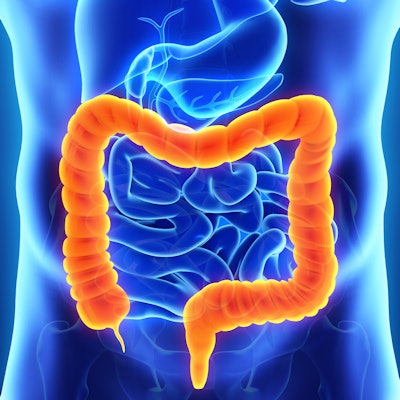
CT colonography (CTC) may be better than conventional CT for staging high-risk colon cancer, improving the identification of patients who could benefit from chemotherapy before undergoing surgery, according to research published in the January issue of the American Journal of Roentgenology.
Preliminary results from the ongoing Fluoropyrimidine, Oxaliplatin, and Targeted-Receptor Preoperative Therapy (FOxTROT) trial revealed that providing neoadjuvant chemotherapy to patients with high-risk colon cancer before surgery helped improve outcomes, compared with the more standard practice of offering adjuvant chemotherapy after surgery.
Currently, the National Comprehensive Cancer Network recommends using colonoscopy with biopsy and CT to evaluate colon cancer patients. But recent studies have suggested that CTC may be more effective than conventional CT for staging these cancers, wrote Dr. Perry Pickhardt from the University of Wisconsin, Dr. Marc Gollub from Memorial Sloan Kettering Cancer Center, and colleagues.
Believing CTC could help pinpoint the most suitable patients for neoadjuvant chemotherapy, the researchers performed CTC scans on 89 patients with colon cancer who were scheduled for surgical treatment. Two abdominal radiologists reviewed the scans and identified 35 high-risk tumors -- stage T4 or T3, extending at least 5 mm beyond the muscularis propria (AJR, January 2019, Vol. 212:1, pp. 94-102).
CTC demonstrated comparable sensitivity and considerably higher specificity than conventional CT in differentiating low- and moderate-risk colon cancers from high-risk ones that were suitable for neoadjuvant chemotherapy.
| CT vs. CTC for identifying high-risk colon cancer | |||
| CT | CTC | ||
| Reader with 1 year of experience | Reader with 5 years of experience | ||
| Sensitivity | 77%* | 65.7% | 82.9% |
| Specificity | 70%* | 81% | 87.9% |
The interreader agreement for classifying high-risk tumors on CTC was substantial (κ = 0.68), and agreement was particularly high for tumor length (0.86) and depth (0.83). However, the agreement decreased markedly when differentiating low-risk tumors. CTC also had inferior accuracy compared with standard CT in detecting extramural venous invasion (EMVI) -- a key risk factor for colon cancer metastases.
The decreased section thickness of CTC scans may be responsible for the improved specificity and reduction in false-positive results compared with standard CT, the authors noted. By reducing false positives, CTC is likely to lower the chance of overtreatment associated with conventional CT.
"If our results are confirmed and standard CT is proven inferior to CTC, patients could receive simultaneous colon cancer staging of distant disease and local staging and risk stratification with CTC using IV contrast medium," they wrote. "Such a study could be performed on the same day as colonoscopy, to reduce the need for additional patient preparation."
"In addition to its established role in occlusive colorectal cancer in assessing the proximal colon, preoperative CT colonography may have a role in differentiating high-risk from low-risk colon cancer," first author Dr. Natally Horvat from Hospital Sírio-Libanês in Brazil told AuntMinnie.com. "If this role can be confirmed, CTC could be a one-stop-shop, all-inclusive diagnostic and risk-assessment examination."




















